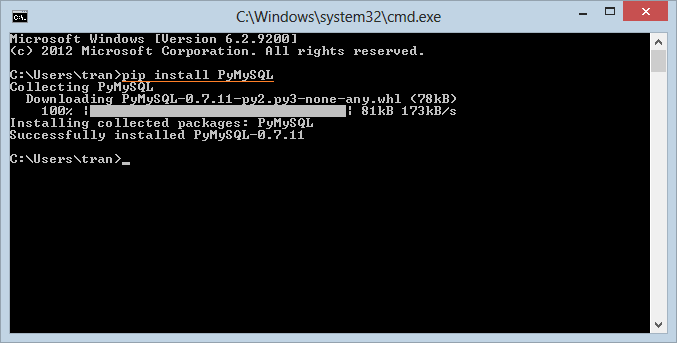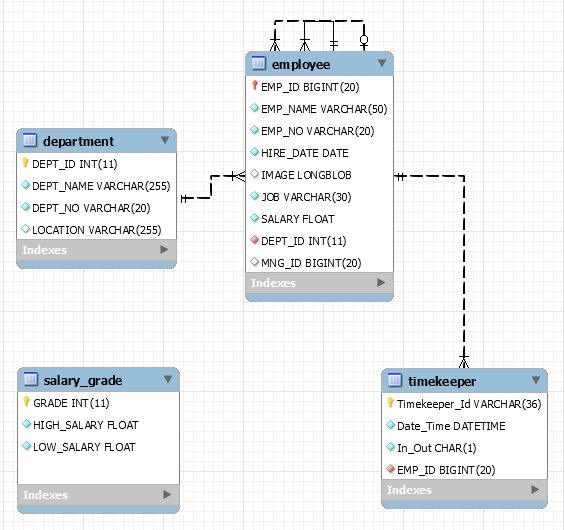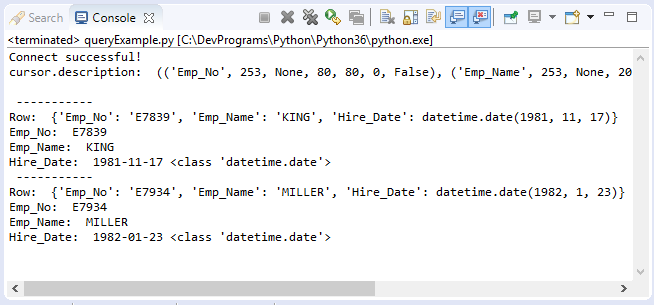Connect to MySQL Database in Python using PyMySQL
1. What is PyMySQL?
In order to connect Python to a database you need a driver, which is a library used to Interact with the database. For MySQL database, you have such 3 Driver choices:
- MySQL/connector for Python
- MySQLdb
- PyMySQL
Driver | Discription |
MySQL/Connector for Python | This is a library provided by the MySQL community. |
MySQLdb | MySQLdb is a library that connects to MySQL from Python, it is written in C language and it is free and open source software. |
PyMySQL | This is a library that connects to MySQL from Python and it is a pure Python library. PyMySQL's goal is to replace MySQLdb and work on CPython, PyPy and IronPython. |
PyMySQL is an open source project, and you can see its source code here:
2. Install PyMySQL
In order to install PyMySQL on Windows (or Ubuntu/Linux) you need to open the CMD window, and run the following statement:
pip install PyMySQL
3. Sample Database
"Simplehr" is a sample database used in many tutorials on o7planning. In the post, I also use it. You can create the database based on the guide below:

4. Connect MySQL from Python with PyMySQL
The following simple example uses Python to connect to MySQL and query the Department table:
connectExample.py
import pymysql.cursors
# Connect to the database.
connection = pymysql.connect(host='192.168.5.134',
user='root',
password='1234',
db='simplehr',
charset='utf8mb4',
cursorclass=pymysql.cursors.DictCursor)
print ("connect successful!!")
try:
with connection.cursor() as cursor:
# SQL
sql = "SELECT Dept_No, Dept_Name FROM Department "
# Execute query.
cursor.execute(sql)
print ("cursor.description: ", cursor.description)
print()
for row in cursor:
print(row)
finally:
# Close connection.
connection.close()Results of the example:
connect successful!!
cursor.description: (('Dept_No', 253, None, 80, 80, 0, False), ('Dept_Name', 253, None, 1020, 1020, 0, False))
{'Dept_No': 'D10', 'Dept_Name': 'ACCOUNTING'}
{'Dept_No': 'D20', 'Dept_Name': 'RESEARCH'}
{'Dept_No': 'D30', 'Dept_Name': 'SALES'}
{'Dept_No': 'D40', 'Dept_Name': 'OPERATIONS'}Utility Module:
The advice here is that you should create a utility module to connect to the database. In case I create a module named as "myconnutils", which defines the getConnection () function to returns a connection.
myconnutils.py
import pymysql.cursors
# Function return a connection.
def getConnection():
# You can change the connection arguments.
connection = pymysql.connect(host='192.168.5.129',
user='root',
password='1234',
db='simplehr',
charset='utf8mb4',
cursorclass=pymysql.cursors.DictCursor)
return connection5. Query Example
The following example queries the Employee table, Python uses %s as a "placeholder" for the parameter, which is independent of the parameter type. For example:
sql1 = "Insert into Department (Dept_Id, Dept_No, Dept_Name) values (%s, %s, %s) "
sql2 = "Select * from Employee Where Dept_Id = %s "queryExample.py
# Use your utility module.
import myconnutils
connection = myconnutils.getConnection()
print ("Connect successful!")
sql = "Select Emp_No, Emp_Name, Hire_Date from Employee Where Dept_Id = %s "
try :
cursor = connection.cursor()
# Execute sql, and pass 1 parameter.
cursor.execute(sql, ( 10 ) )
print ("cursor.description: ", cursor.description)
print()
for row in cursor:
print (" ----------- ")
print("Row: ", row)
print ("Emp_No: ", row["Emp_No"])
print ("Emp_Name: ", row["Emp_Name"])
print ("Hire_Date: ", row["Hire_Date"] , type(row["Hire_Date"]) )
finally:
# Close connection.
connection.close()
6. Insert Example
insertExample.py
# Use your utility module.
import myconnutils
import pymysql.cursors
connection = myconnutils.getConnection()
print ("Connect successful!")
try :
cursor = connection.cursor()
sql = "Select max(Grade) as Max_Grade from Salary_Grade "
cursor.execute(sql)
# 1 row.
oneRow = cursor.fetchone()
# Output: {'Max_Grade': 4} or {'Max_Grade': None}
print ("Row Result: ", oneRow)
grade = 1
if oneRow != None and oneRow["Max_Grade"] != None:
grade = oneRow["Max_Grade"] + 1
cursor = connection.cursor()
sql = "Insert into Salary_Grade (Grade, High_Salary, Low_Salary) " \
+ " values (%s, %s, %s) "
print ("Insert Grade: ", grade)
# Execute sql, and pass 3 parameters.
cursor.execute(sql, (grade, 2000, 1000 ) )
connection.commit()
finally:
connection.close()Output:
connect successful!!
Row Result: {'Max_Grade': 2}
Insert Grade: 37. Update Example
updateExample.py
# Use your utility module.
import myconnutils
import pymysql.cursors
import datetime
connection = myconnutils.getConnection()
print ("Connect successful!")
try :
cursor = connection.cursor()
sql = "Update Employee set Salary = %s, Hire_Date = %s where Emp_Id = %s "
# Hire_Date
newHireDate = datetime.date(2002, 10, 11)
# Execute sql, and pass 3 parameters.
rowCount = cursor.execute(sql, (850, newHireDate, 7369 ) )
connection.commit()
print ("Updated! ", rowCount, " rows")
finally:
# Close connection.
connection.close()Output:
connect successful!
Update! 1 rows8. Delete Example
deleteExample.py
# Use your utility module.
import myconnutils
connection = myconnutils.getConnection()
print ("Connect successful!")
try :
cursor = connection.cursor()
sql = "Delete from Salary_Grade where Grade = %s"
# Execute sql, and pass 1 parameters.
rowCount = cursor.execute(sql, ( 3 ) )
connection.commit()
print ("Deleted! ", rowCount, " rows")
finally:
# Close connection.
connection.close()Output:
connect successful!
Deleted! 1 rows9. Call Procedure
There are some problems when you call a function or procedure in Python. I set up a situation like this:
You have a procedure:
- Get_Employee_Info(p_Emp_Id, v_Emp_No, v_First_Name, v_Last_Name, v_Hire_Date)
get_Employee_Info
DELIMITER $$
-- This procedure retrieves information of an employee,
-- Input parameter: p_Emp_ID (Integer)
-- There are four output parameters v_Emp_No, v_First_Name, v_Last_Name, v_Hire_Date
CREATE PROCEDURE get_Employee_Info(p_Emp_ID Integer,
out v_Emp_No Varchar(50) ,
out v_First_Name Varchar(50) ,
Out v_Last_name Varchar(50) ,
Out v_Hire_date Date)
BEGIN
set v_Emp_No = concat( 'E' , Cast(p_Emp_Id as char(15)) );
--
set v_First_Name = 'Michael';
set v_Last_Name = 'Smith';
set v_Hire_date = curdate();
ENDThe procedure above has an input parameter p_Emp_Id and the four output parameters v_Emp_No, v_First_Name, v_Last_Name, v_Hire_Date, and you call this procedure from Python passing the value to p_Emp_Id to get 4 output values. Unfortunately, the value received is not guaranteed to be true (as stated in the DB-API specification). Python can only retrieve values from a SELECT clause.
DB-API specification:def callproc(self, procname, args=()): """Execute stored procedure procname with args procname -- string, name of procedure to execute on server args -- Sequence of parameters to use with procedure Returns the original args. Compatibility warning: PEP-249 specifies that any modified parameters must be returned. This is currently impossible as they are only available by storing them in a server variable and then retrieved by a query. Since stored procedures return zero or more result sets, there is no reliable way to get at OUT or INOUT parameters via callproc. The server variables are named @_procname_n, where procname is the parameter above and n is the position of the parameter (from zero). Once all result sets generated by the procedure have been fetched, you can issue a SELECT @_procname_0, ... query using .execute() to get any OUT or INOUT values. Compatibility warning: The act of calling a stored procedure itself creates an empty result set. This appears after any result sets generated by the procedure. This is non-standard behavior with respect to the DB-API. Be sure to use nextset() to advance through all result sets; otherwise you may get disconnected. """
However you can still solve the problem above, you need to wrap Get_Employee_Info procedure by another procedure (for example Get_Employee_Info_Wrap), this procedure returns the values from the SELECT clause.
get_Employee_Info_Wrap
DROP procedure IF EXISTS `get_Employee_Info_Wrap`;
DELIMITER $$
-- This procedure wrap Get_Employee_info
CREATE PROCEDURE get_Employee_Info_Wrap(p_Emp_ID Integer,
out v_Emp_No Varchar(50) ,
out v_First_Name Varchar(50) ,
Out v_Last_name Varchar(50) ,
Out v_Hire_date Date)
BEGIN
Call get_Employee_Info( p_Emp_Id, v_Emp_No, v_First_Name, v_Last_Name, v_Hire_Date);
-- SELECT
Select v_Emp_No, v_First_Name, v_Last_Name, v_Hire_Date;
ENDInstead of calling the Get_Employee_Info procedure in Python, call Get_Employee_Info_Wrap procedure.
callProcedureExample.py
# Use your utility module.
import myconnutils
import datetime
connection = myconnutils.getConnection()
print ("Connect successful!")
try :
cursor = connection.cursor()
# Get_Employee_Info_Wrap
# @p_Emp_Id Integer ,
# @v_Emp_No Varchar(50) OUTPUT
# @v_First_Name Varchar(50) OUTPUT
# @v_Last_Name Varchar(50) OUTPUT
# @v_Hire_Date Date OUTPUT
v_Emp_No = ""
v_First_Name= ""
v_Last_Name= ""
v_Hire_Date = None
inOutParams = ( 100, v_Emp_No, v_First_Name , v_Last_Name, v_Hire_Date )
resultArgs = cursor.callproc("Get_Employee_Info_Wrap" , inOutParams )
print ('resultArgs:', resultArgs )
print ( 'inOutParams:', inOutParams )
print (' ----------------------------------- ')
for row in cursor:
print('Row: ', row )
print('Row[v_Emp_No]: ', row['v_Emp_No'] )
print('Row[v_First_Name]: ', row['v_First_Name'] )
print('Row[v_Last_Name]: ', row['v_Last_Name'] )
# datetime.date
v_Hire_Date = row['v_Hire_Date']
print('Row[v_Hire_Date]: ', v_Hire_Date )
finally:
# Close connection.
connection.close()Run the example:
connect successful!
resultArgs: (100, '', '', '', None)
inOutParams: (100, '', '', '', None)
-----------------------------------
Row: {'v_Emp_No': 'E100', 'v_First_Name': 'Michael', 'v_Last_Name': 'Smith', 'v_Hire_Date': datetime.date(2017, 5, 17)}
Row[v_Emp_No]: E100
Row[v_First_Name]: Michael
Row[v_Last_Name]: Smith
Row[v_Hire_Date]: 2017-05-1710. Call Function
To call a function in Python, you should create a query clause, and execute this query.
Here is the Get_Emp_No function, the input parameter is p_Emp_Id and returns Emp_No (Employee Code).
Get_Emp_No
DROP function if Exists `Get_Emp_No`;
DELIMITER $$
CREATE Function Get_Emp_No (p_Emp_Id Integer) Returns Varchar(50)
Begin
return concat('E', CAST(p_Emp_Id as char)) ;
END;callFunctionExample.py
# Use your utility module.
import myconnutils
import datetime
connection = myconnutils.getConnection()
print ("Connect successful!")
try :
cursor = connection.cursor()
# Get_Employee_Info_Wrap
# @p_Emp_Id Integer
v_Emp_No = ""
inOutParams = ( 100 )
sql = "Select Get_Emp_No(%s) as Emp_No "
cursor.execute(sql, ( 100 ) )
print (' ----------------------------------- ')
for row in cursor:
print('Row: ', row )
print('Row[Emp_No]: ', row['Emp_No'] )
finally:
# Close connection.
connection.close()Running the example:
connect successful!
-----------------------------------
Row: {'Emp_No': 'E100'}
Row[Emp_No]: E100Python Programming Tutorials
- Lookup Python documentation
- Branching statements in Python
- Python Function Tutorial with Examples
- Class and Object in Python
- Inheritance and polymorphism in Python
- Python Dictionary Tutorial with Examples
- Python Lists Tutorial with Examples
- Python Tuples Tutorial with Examples
- Python Date Time Tutorial with Examples
- Connect to MySQL Database in Python using PyMySQL
- Python exception handling Tutorial with Examples
- Python String Tutorial with Examples
- Introduction to Python
- Install Python on Windows
- Install Python on Ubuntu
- Install PyDev for Eclipse
- Conventions and Grammar versions in Python
- Python Tutorial for Beginners
- Python Loops Tutorial with Examples
Show More